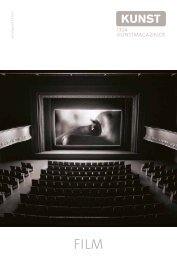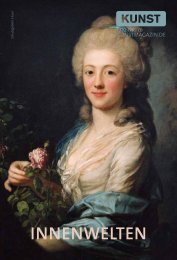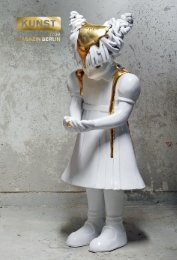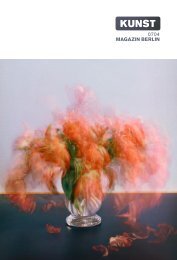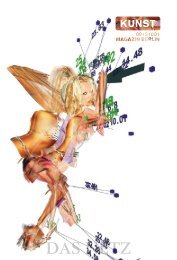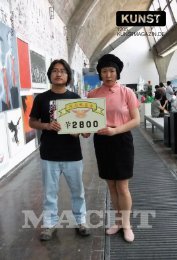Download als .pdf - KUNST Magazin
Download als .pdf - KUNST Magazin
Download als .pdf - KUNST Magazin
Erfolgreiche ePaper selbst erstellen
Machen Sie aus Ihren PDF Publikationen ein blätterbares Flipbook mit unserer einzigartigen Google optimierten e-Paper Software.
Sammlergespräch mit Thomas Olbricht und<br />
Jonas Burgert – Ein freiwilliger Weg<br />
Conversations with Collectors: Thomas Olbricht and<br />
Jonas Burgert—A Path Freely Chosen<br />
Interview: Jan Kage<br />
Text: Esther Knuth, Stefanie Raupach, Sonja Wunderlich<br />
Ende April sind 29 der vergangenen <strong>KUNST</strong> <strong>Magazin</strong>-<br />
Sammlergespräche <strong>als</strong> Buch erschienen. Im Rahmen des<br />
Sammlergesprächs zwischen dem Sammler Thomas Olbricht,<br />
dem Maler Jonas Burgert und dem langjährigen<br />
Moderator der Gespräche, Jan Kage, fand die Buchpräsentation<br />
statt. Es war das siebte Sammlergespräch, das<br />
in Kooperation mit der Stiftung von Thomas Olbricht<br />
im me Collectors Room in der Berliner Auguststraße 68<br />
stattfand.<br />
Thomas, wie hast du Jonas kennengelernt?<br />
TO: Jürgen Vorrath von der Produzentengalerie Hamburg<br />
hat mich 2005 auf Jonas aufmerksam gemacht,<br />
er hatte dam<strong>als</strong> in der Kunsthalle an einer Gruppenausstellung<br />
teilgenommen. Ich fand seine Bilder sehr<br />
spannend und habe gleich etwas erworben. Auf einer<br />
späteren Berlinreise sprach mich dann die Regisseurin<br />
Nicola Graef auf die von Jonas Burgert geleitete Ausstellung<br />
„Fraktale“ an, die im noch nicht ganz abgerissenen<br />
Palast der Republik stattfinden sollte. Jonas und ich haben<br />
uns getroffen und uns gut verstanden. Ich habe die<br />
Ausstellung dann mit einem kleinen Beitrag finanziell<br />
unterstützt.<br />
JB: Die Fraktale war eine sehr idealistische Geschichte.<br />
Thomas’ finanzielles Engagement war kein Sponsoring,<br />
sondern Ausdruck seiner Überzeugung, uns zu unterstützen.<br />
Wir wollten grundsätzlich nichts verkaufen.<br />
Translation: Brian Poole<br />
Towards the end of April <strong>KUNST</strong> <strong>Magazin</strong> published<br />
its previous 29 “Conversations with Collectors” in book<br />
form. After the book presentation, a conversation was<br />
held between the collector Thomas Olbricht, the painter<br />
Jonas Burgert, and our longstanding moderator Jan<br />
Kage. This was the seventh “Conversation with Collectors”<br />
staged at Thomas Olbricht’s Foundation, the “me<br />
Collectors Room” at Berlin’s Auguststrasse 68.<br />
Thomas, how did come to you meet Jonas?<br />
TO: Jürgen Vorrath from the Produzentengalerie Hamburg<br />
called my attention to Jonas, who had recently<br />
been participating in a group exhibition at the Kunsthalle<br />
in Hamburg. I found his paintings very stimulating<br />
and immediately bought something. During a later trip<br />
to Berlin, the film director Nicola Graef mentioned the<br />
exhibition “Fraktale” that Jonas Burgert had organised,<br />
which was due to be held in the Palace of the Republic<br />
before it was torn down. Jonas and I met and had a most<br />
agreeable conversation. Thereafter, I supported the exhibition<br />
with a small financial contribution.<br />
JB: The “Fraktale” was a very idealistic project. Thomas’s<br />
financial contribution was not a sponsorship, but rather<br />
an expression of his conviction that we were worthy of<br />
support. Fundamentally, we didn’t want to sell anything.<br />
So wie ein Künstler seinen Stil finden muss, so hat auch<br />
jeder Sammler seinen Geschmack, seinen Stil. Das ist<br />
nur ein Fazit der vergangenen drei Jahre. Das Besondere<br />
an deinem Ausstellungsraum, Thomas, verglichen mit<br />
anderen Räumen privater Sammler, ist aber, dass du<br />
hier auch andere Sammlungen wie die von Antoine de<br />
Galbert aus Paris zeigst.<br />
TO: Bevor ich diesen Raum eröffnete, hatte ich das Gespräch<br />
mit anderen Sammlern nicht aktiv gesucht. Ich<br />
stamme ja vom Land und war die sozialen Gepflogenheiten<br />
nicht gewohnt. Hier in Berlin hat sich eine ganz<br />
neue Welt für mich eröffnet. Ich hatte das Gefühl, dass<br />
unter den Sammlern und auch zu den Künstlern gute<br />
Kontakte bestehen. Man versteht sich einfach. Das „me“<br />
im Namen der Stiftung steht für „moving energies“ und<br />
bezieht sich darauf, dass wir verschiedenste Kunstrichtungen<br />
zeigen, aber auch andere Sammler einladen<br />
wollen. Eine interessante, vielfältige Mischung mag ich<br />
am liebsten. Deswegen zeigen wir hier auch internationale<br />
Sammlungen aus Frankreich, Italien und der Türkei<br />
und Zusammenstellungen, die man vielleicht an anderen<br />
Stellen so nicht sieht.<br />
Redet man unter Sammlern rein inhaltlich über die<br />
Werke oder ist das wie bei Kindern, die vergleichen, wer<br />
die dickere Briefmarkensammlung hat?<br />
TO: Ich rede eigentlich nicht so gerne über die Arbeiten.<br />
Ich bin vielmehr ein Augenmensch und liebe Farben.<br />
Deswegen ist es hier so bunt. Farben spielen auch in vielen<br />
Bildern eine wesentliche Rolle.<br />
JB: Die Kunst soll ja auch etwas anderes tun, nämlich<br />
einen Inhalt in eine andere Sprache und einen anderen<br />
Gestus transformieren. Mit meinen wirklich guten<br />
Freunden rede ich auch selten inhaltlich über meine<br />
Arbeiten. Das hängt damit zusammen, dass das eigentliche<br />
Thema einer Arbeit sehr persönlich ist, wie bei<br />
einem Sammler der Geschmack, der bestimmt, was er<br />
wirklich kauft und was ihn reizt. Aber wenn irgendeine<br />
Farbe in einem meiner Bilder nicht funktioniert, dann<br />
kriege ich das von den Freunden um die Ohren gehauen.<br />
Die Bildsprache, in die die Kunst Inhalte transformiert,<br />
wird auf den Tisch gelegt und kann knallhart angegriffen,<br />
aber auch gelobt werden. Mein Gegenüber hat das<br />
Recht zu sagen, dass es meine Sprache nicht verstehen<br />
kann, ganz gleich, was meine emotionale Haltung dazu<br />
ist, und sei sie noch so gut – wenn meine Sprache nicht<br />
gelesen werden kann, wenn ich nicht da bin, gibt es ein<br />
Problem. Deswegen interessiert mich der Subtext immer<br />
sehr stark. Innerhalb der Kunst gibt es eine Thematik,<br />
die ich intellektuell nachvollziehen kann, aber es gibt<br />
auch eine Ebene, auf der die Empfindung das Regiment<br />
übernimmt. Elemente wie ein Kalt-Warm-Kontrast<br />
können meiner Meinung nach sehr viel bewirken. Wir<br />
denken zwar nicht in kalten und warmen Farben, aber<br />
wir empfinden sie innerhalb kürzester Zeit. Ich habe<br />
auch den Eindruck, diese zweite Ebene setzt sich über<br />
die erzählten Geschichten hinweg. Wenn ich beispielsweise<br />
eine Skulptur von den alten Sumerern ansehe –<br />
Much as an artist has to find his style, every collector<br />
has his own taste and his own style. That is only one of<br />
the conclusions we can draw from the past three years.<br />
What I find special about your gallery, Thomas, by comparison<br />
with other galleries of private collectors, is that<br />
you <strong>als</strong>o exhibit other collections, like the collection of<br />
Antoine de Galbert from Paris.<br />
TO: Before I opened this space, I hadn’t actively sought<br />
conversations with other collectors. I was raised in a<br />
rural environment, so I wasn’t used to the social conventions.<br />
Here in Berlin, another world opened up for<br />
me. I had the feeling that the collectors communicated<br />
avidly with each other, and <strong>als</strong>o with the artists. They<br />
simply get along well with each other. The “me” in the<br />
name of our Foundation stands for “moving energies”<br />
and refers to the fact that we show various directions<br />
in art, and we <strong>als</strong>o want to invite other collectors. Most<br />
of all, I like to have an interesting and diverse mixture.<br />
And that’s why we <strong>als</strong>o exhibit international collections<br />
from France, Italy, and Turkey, as well as composite exhibitions<br />
that one would not perhaps see anywhere else.<br />
Do collectors talk only about content when they discuss<br />
works, or do they do what kids do when they try to figure<br />
out who’s got the largest stamp collection?<br />
TO: Actually, I don’t really like to talk about artworks. I’m<br />
more visually oriented, and I love colours. That’s why it’s<br />
so colourful here. Colours <strong>als</strong>o play an essential role in<br />
many pictures.<br />
JB: Art is <strong>als</strong>o supposed to do something else, namely:<br />
to transform content into another language and another<br />
manner of expression. Even with my really good<br />
friends, I <strong>als</strong>o rarely talk about the content of my works.<br />
That has to do with the fact that the actual theme of a<br />
work is very personal—like the taste of a collector who<br />
decides what he ultimately wants to buy and what he<br />
finds stimulating. But when one of the colours in one of<br />
my pictures doesn’t work, I can be sure I’ll hear about it<br />
from my friends. The language of painting, into which<br />
art transforms content, is laid out like cards on a table,<br />
and it can be brutally criticised, but <strong>als</strong>o praised. The<br />
people I talk to have the right to tell me they can’t understand<br />
my language, no matter what my emotional<br />
opinion about that may be; and, no matter how good<br />
it may be, if my language can’t be read when I’m not<br />
there, that’s a problem. That’s why I’m very interested<br />
in the subtext. Within art there are themes that I can<br />
comprehend intellectually, but there is <strong>als</strong>o a level on<br />
which the feeling takes command. Elements such as<br />
contrasts between cold and warm shades can, in my<br />
opinion, accomplish quite a lot. We don’t actually think<br />
in cold and warm colours, but we sense them within a<br />
short amount of time. I <strong>als</strong>o have the impression that<br />
this second level extends well beyond the narrated stories.<br />
For example, when I look at an ancient Sumerian<br />
sculpture that’s so old that I don’t have an immediate<br />
relation to it, it still works. Such phenomena are embedded<br />
in a larger context—one that implies a certain<br />
18<br />
19



